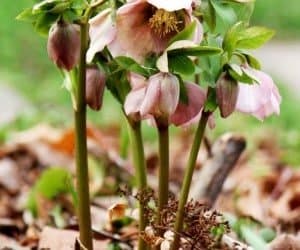It’s been another week of challenging weather patterns. After an extended period of early warmth, in came several nights of frosty temperatures. The blooming hellebores were bent down with the cold air, and predictions of snow sent me scurrying into the garden to cover emerging bleeding-hearts. Covering plants can elevate air temperature by two to five degrees under the covering, and that might be all that’s needed to avoid frost injury.

I also needed to carry heavy containers of pansies into the garage at night and back out again in the morning. This nonsense has to stop! Of course, this wouldn’t happen if I would just be patient, and not get the urge for pansies at the earliest possible moment. But who can resist? Certainly not me. I’ll continue protecting plants from frost when necessary and hope for the best.
I’ve had good results placing overturned pots, buckets and heavy corrugated boxes on early-blooming plants at night. Of course, my front garden looks like a junkyard in the morning, but that’s okay with me. The timing is important—the coverings should be placed over the plants in late afternoon, before the temperature falls below freezing; this allows heat radiating from the ground to be trapped around the plant. Remove the covers the following morning to prevent overheating as the sun warms the air.
Heavy stone containers with plants are hard to move, and often the wrong size and shape for protective pots and boxes. Woven fabric of all kinds is a good insulating material and works better than plastic. Burlap, lightweight curtains and pillowcases can be draped and fitted over plants and will trap heat in the woven layers. Even in early summer, if night temperature is predicted to fall below 13°C, tomatoes will suffer. Tucking them into a spare pillowcase will save tender foliage and blossoms.
Regardless of what plants I might need to protect from frost, it’s essential that their soil be moist. Frost easily enters dry soil and freezes root tissues; moist soil holds temperatures just above freezing.
Other posts by Judith this week:
Posts by Judith last week:

I think spring frost is just a fact of life. We never worry too much about any spring damage to perennials at any stage. Some of the hellebores and early corydalis seem to cope.
Later on(early May here) frosts can certainly play havoc with early blooming rhododendrons. There again, not much can be done to prevent it. We have far too many plants to even consider covering “anyone” up.